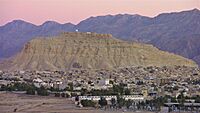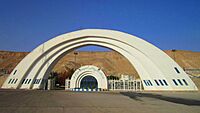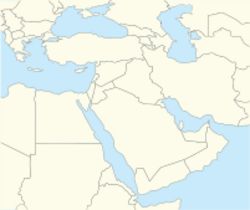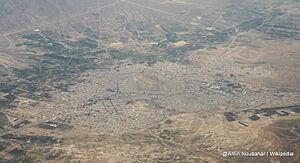Gerash facts for kids
Quick facts for kids
Gerash
Persian: گراش
|
|
|---|---|
|
From top, left to right: Gerash skyline and Kalat mountain, Berkeh Haj Asadollah, Haft Berkeh, College of Medical Sciences entrance, Akhond mosque, The nature of Gerash in spring
|
|
| Country | Iran |
| Province | Fars |
| County | Gerash |
| District | Central |
| Area | |
| • Total | 15.65 km2 (6.04 sq mi) |
| Elevation | 914 m (2,999 ft) |
| Population
(2016)
|
|
| • Total | 34,469 |
| • Density | 2,202.5/km2 (5,704.4/sq mi) |
| • Population Rank in Fars Province | 15th |
| • Population Rank in Iran | 243rd |
| Demonym(s) | Achomi |
| Time zone | UTC+3:30 (IRST) |
| Area code(s) | (+98) 071 |
Gerash (Persian: گراش) is a city in Fars province, Iran. It is the main city of Gerash County.
History of Gerash
Long ago, the people of Gerash followed the Zoroastrian religion. In the 11th century AD, they became Shia Muslim. This change happened with the help of Amir Mohi al-Din, a descendant of Muhammad.
Many people from Gerash have moved to countries around the Persian Gulf, like the UAE, Qatar, Bahrain, and Kuwait. They often work in small shops or help move goods. More recently, some have moved to the United Kingdom, United States, and Canada. Students also like to study in Eastern Europe because it is more affordable.
People and Language
What Language Do Gerashis Speak?
People in Gerash speak a language called Achomi. Many nearby cities, like Evaz and Khonj, also speak Achomi. In Gerash, there are two main ways of speaking Achomi: Nassagi and Barqe-Roozi (also known as Belalizi).
Gerashis often call themselves "Khodmooni." This means "part of ourselves." It is used for people from Gerash and other nearby cities who share the Achomi language.
How Many People Live in Gerash?
In 2006, about 27,574 people lived in Gerash. By 2011, the population grew to 30,593. The latest count in 2016 showed 34,469 people living in the city. The population can change a lot because some people move away for certain seasons. However, the total population is thought to be around 50,000.
Places to Visit
Historical Buildings and Sites
Gerash has many interesting historical places. These sites show the city's long history and culture.
Kalat Hill
The most famous landmark in Gerash is Kalat. This hill is right in the middle of the city. Houses are built all around it. In the past, Kalat was home to brave warriors. They used a fort called "Kalaa" on the hill to protect the city. This fort is now gone, but the hill remains important.
Ancient Water Storages (Berkeh)
Water storages, called Berkeh or Ab Anbar, are very important to the people of Gerash. Many kind people built these to help save water. Even today, with modern water pipes, these traditional storages are still valued.
Berke Kaal (Kal Pond)
This water storage is one of the largest and most amazing in Iran. It is very old, but no one knows exactly when it was built. It was built by Haaj Asad-o-llah.
The inside of the pond is 19 meters (about 62 feet) wide. It is 21 meters (about 69 feet) deep, which is like a seven-story building! People say its dome fell down after it was built. Even so, building such a large dome with old materials was a great achievement.
The pond has six openings to collect rainwater. All six were also used to get water out. Stone stairs inside let people go down to the bottom. The pond's tank is round and made of strong mortar. The bottom is wider than the top, making it easier to get water.
Seven Water Storages (Seven Ponds)
These seven water storages are close together. They were built at different times and are of different sizes. They are located near a seasonal river in the Nasag Neighborhood. Five of them have roofs, and two do not.
The biggest and most famous one is called Haj Abol-Hassan Pond. It was built by Haj Abol-hassan. Its special feature is that its tank wall goes all the way to the bottom from its openings. The tank is round, and its bottom is flat with the openings. This group of ponds is a nationally registered heritage site in Iran.
Tag-e-Av Historical Dam
The city of Gerash is very old, dating back to the Sasanian period (224-651 A.D.). This is known because of an old dam called "Tag-e-Av."
The Tag-e-Av dam is in a canyon southwest of Gerash. It was built during the Sasanian era. It was repaired during the Safavid period, when three clamps were added to keep it strong. The dam and clamps are made of stone and mortar. A water channel was built from the dam to a plain for farming. Two pools were also built along this channel. Today, the area behind the dam is filled with dirt, and a cedar tree grows there. This dam became a national heritage site in 2001.
Gerash Castle (Homayoun Dezh)
The ruins of Gerash Castle are on a large hill called "Kalaat," which is 1070 meters (about 3,510 feet) above sea level. The city grew around this hill. The castle used to have houses, a mosque, a bath, a prison, and water storages.
On the north side of the castle was a large house called Narenj. This house belonged to the ruler. It had two small rooms upstairs in the north and mirrored rooms in the east. There was also a tower called "Borj-e-Baargaah" on the south side.
Azimis House (Anthropology Museum)
The House of Azimis is shaped like an "L." When you enter, you come into a central yard, which is common in old Gerash houses. This house is special because each floor has its own porch (Ivan) instead of one big porch going up all floors.
This house has been restored by the Gerash Cultural Heritage Lovers Society. It is now a nationally registered cultural heritage site and an anthropology museum. This means it is one of the best-preserved historical buildings in the city.
Images for kids
See also
 In Spanish: Gerash para niños
In Spanish: Gerash para niños
















